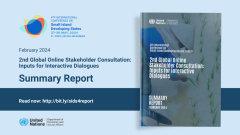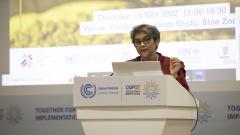- عربي
- 中文
- English
- Français
- Русский
- Español
Milo Milfort
Competition Winner: Milo Milfort
Milo Milfort studied Social Communication and Public Administration at the State University of Haiti and Photography at the Center of Photographic and Cinematographic Studies. From March 2016, he started working as a freelance photographer/ journalist with the Haitian weekly based in New York, Haiti Liberté. He also writes for Mag Haiti, an online media. In September 2016, he was among the 10 winners of the 2nd edition of the “Young Journalist Award of Haiti.” In February 2017, Milo Milfort founded Enquet’Action, an independent, critical and alternative investigative media whose mission is to carry out journalistic investigations on subjects of public interest.
Renewable Energy is the Future for Haiti
Click here to read to the original story in French
Low access rates, mediocre quality services, unequal access to electricity for the population. The energy system in Haiti is subject to eternal challenges that constitute a major obstacle to reducing poverty in a country, yet with high potential of clean energies.
In the face of these limitations, non-state actors are proposing alternatives to use renewable energies to provide electricity to marginalized and forgotten populations of state authorities.
At homes, electricity replaces harmful and dangerous lamps, reduces spending on energy sources (kerosene, candles, telephone charging, etc.) and saves valuable time by replacing dangerous manual work and the daily quest for fuel (wood and water), a chore generally provided by women and girls.
For some years now, the social reality is quite different at Mole St Nicolas, for Jean Rabel and Bombardopolis in the northwestern department of Haiti. The sustainable energy used positively affects the lives of no less than 20 thousand people – living in some of Haiti’s poorest regions, says Mag Haiti. They are part of the small minority who have access to affordable electricity 24/7 in a country where ¾ of the population do not have this opportunity and where those who have it – have to deal with intermittent access from 5 to 9 hours a day. That has not been always the situation. Previously, electricity was a luxury for the people of the Northwest who live in a region with great potential for renewable energy, as well as an untapped potential for communities to develop.
“Before the arrival of Sigora, those who can, have tried to find an answer to the blackout that reigned there. Churches, businesses and the better-off got inverter, batteries, solar panels and generators. Those who cannot afford such luxury – deprived of electric energy – used a kerosene lamp as lighting in the evening”, recalls Remy Julmisse, CEO of Radio TV Jean Rabel (RTJR). The native of Jean Rabel indicates that there was electricity in his country in the 80s-90 from 10am to midnight, and after – periods of blackout followed. This, despite the attempt to implement a large electrification project by the former President René Préval during his second term – which has not succeeded.
In Haiti, between 25 to 30% of the population in urban areas and less than 5% in rural areas have access to electricity, according to official figures. In the Latin America and Caribbean region, the country has the lowest electrification rate and the largest number of people without access to electricity – more than 8 million. “The cost is affordable. Since the electrification of several regions, people stay much later in the streets. The radios operate 24 hours a day, yet before they worked only 5 hours a day. City lighting creates a safer climate. And, everyone turns into a shopkeeper”, adds Julmisse Sigora customer since mid-2017. The head of media announces the opening of a television channel soon in the city. “Lately, a cutout of the electricity from 7am to 10pm – has created a climate of panic on the city because people are not used to blackout”; he says. He reveals that remote communal sections still do not have access to electricity. This blackout occurred because of the required system maintenance. A customer can recharge his account from 25 gourdes. He can do it, but someone else who knows his number can buy him hours of electricity. With 25 gourdes, the recipient with two bulbs and phones to recharge, can have power for 24 hours.
The availability of 24/7 electric power has allowed companies to stop using their diesel generators, many of which were oversized and poorly maintained. In schools and clinics, workers report improvements in service delivery through 24/7 food.
Consistent service is essential for businesses, large and small, to thrive. Businesses lose on average 5 to 15% of their sales due to frequent power outages. This figure rises to 20% for informal companies unable to afford relief, according to a study by the Dalberg Group titled "Improving access to electricity through decentralized renewable energy, case study policy, released in May 2017.
Since they are connected to the electricity provided by Sigora Haiti, sellers stay open longer at night, extending their productive sales hours between 3 and 5 hours a day.
Sustainable energy at the grassroots?
At the base of these changes in living conditions and existence, is the arrival of the company Sigora Haiti that produces electricity through a combination of solar energy and diesel generators, and who will soon add battery storage . Sigora operates hybrid networks that leverage Haiti's vast renewable energy potential to provide reliable power to the communities it serves.
 "Before Sigora, students were studying on candlelight or kerosene, which emitted harmful fumes, while others were forced to leave their homes to study in the light of streetlamps. Today, this is no longer the case”, proudly supports Natasha Skreslet, Impact and Communications Director at Sigora Haiti.
"Before Sigora, students were studying on candlelight or kerosene, which emitted harmful fumes, while others were forced to leave their homes to study in the light of streetlamps. Today, this is no longer the case”, proudly supports Natasha Skreslet, Impact and Communications Director at Sigora Haiti.
The company started with a dream of electrifying a clinic and became today a large-scale green utility project. This utility company generates, distributes and sells energy directly to the end customer, and provides electricity 24 hours a day, 7 days a week, clean, reliable and at a reasonable price to some underserved communities in Haiti.
"We envision communities where children can study at night, where adults have many job opportunities and where businesses thrive"; she adds. From 2015 to date, Sigora Haiti - subsidiary of Sigora International based in San Francisco in the United States - is 4 micro-networks, 4,000 connections and 20,000 customers. Currently, its production capacity is 1.25 MW. Once the first phase of the North-West Electrification Project has been completed, the company promises to expand its network to 136 thousand or 27 thousand accounts. This, with a renewable energy capacity of 3.5 MWp.
The institution welcomes the initiatives of the government of Haitian President Jovenel Moise to expand access to electricity. "We are ready to work with all stakeholders to advance this important goal"; said Natasha Skreslet, admitting the benefits of a prepaid system adopted by her company. Without minimal monthly expenses, even the smallest customer can afford to connect, and customers pay only for what they use.
"Renewable energies - that's the future in Haiti. New electricity service approaches that exploit smart meters, prepaid electricity and solar power plants hold the promise of sustainably expanding access to energy in previously underserved and unconnected areas of the country", concludes Natasha Skreslet.
According to Haiti';s sustainable energy roadmap released in November 2014, only 6 square kilometers of solar photovoltaic panels would be able to produce as much electricity as Haiti produced in 2011. The study compares the economic and societal costs of electricity. current electricity sector in Haiti and its usual development to that of alternative routes and concludes that Haiti will benefit enormously if it relies more heavily on renewable energy sources and less on fossil fuels.






